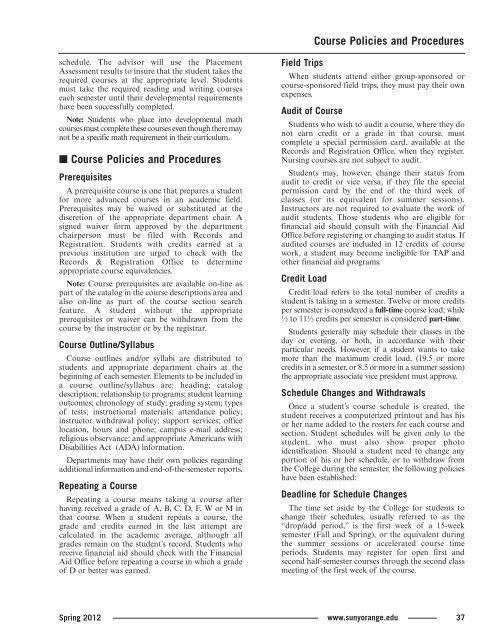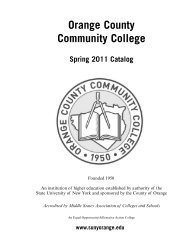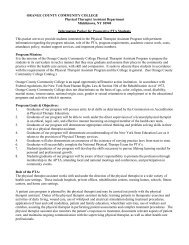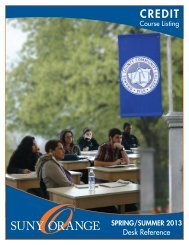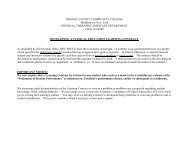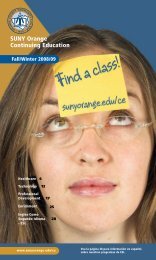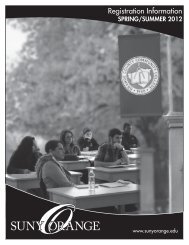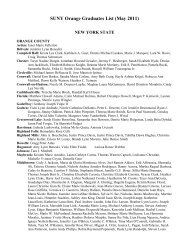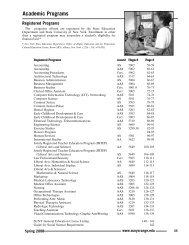Indexed Adobe PDF (Spring 2012 - Full Version) - SUNY Orange
Indexed Adobe PDF (Spring 2012 - Full Version) - SUNY Orange
Indexed Adobe PDF (Spring 2012 - Full Version) - SUNY Orange
You also want an ePaper? Increase the reach of your titles
YUMPU automatically turns print PDFs into web optimized ePapers that Google loves.
Course Policies and Procedures<br />
schedule. The advisor will use the Placement<br />
Assessment results to insure that the student takes the<br />
required courses at the appropriate level. Students<br />
must take the required reading and writing courses<br />
each semester until their developmental requirements<br />
have been successfully completed.<br />
Note: Students who place into developmental math<br />
courses must complete these courses even though there may<br />
not be a specific math requirement in their curriculum.<br />
■ Course Policies and Procedures<br />
Prerequisites<br />
A prerequisite course is one that prepares a student<br />
for more advanced courses in an academic field.<br />
Prerequisites may be waived or substituted at the<br />
discretion of the appropriate department chair. A<br />
signed waiver form approved by the department<br />
chairperson must be filed with Records and<br />
Registration. Students with credits earned at a<br />
previous institution are urged to check with the<br />
Records & Registration Office to determine<br />
appropriate course equivalencies.<br />
Note: Course prerequisites are available on-line as<br />
part of the catalog in the course descriptions area and<br />
also on-line as part of the course section search<br />
feature. A student without the appropriate<br />
prerequisites or waiver can be withdrawn from the<br />
course by the instructor or by the registrar.<br />
Course Outline/Syllabus<br />
Course outlines and/or syllabi are distributed to<br />
students and appropriate department chairs at the<br />
beginning of each semester. Elements to be included in<br />
a course outline/syllabus are: heading; catalog<br />
description; relationship to programs; student learning<br />
outcomes; chronology of study; grading system; types<br />
of tests; instructional materials; attendance policy;<br />
instructor withdrawal policy; support services; office<br />
location, hours and phone; campus e-mail address;<br />
religious observance; and appropriate Americans with<br />
Disabilities Act (ADA) information.<br />
Departments may have their own policies regarding<br />
additional information and end-of-the-semester reports.<br />
Repeating a Course<br />
Repeating a course means taking a course after<br />
having received a grade of A, B, C, D, F, W or M in<br />
that course. When a student repeats a course, the<br />
grade and credits earned in the last attempt are<br />
calculated in the academic average, although all<br />
grades remain on the student’s record. Students who<br />
receive financial aid should check with the Financial<br />
Aid Office before repeating a course in which a grade<br />
of D or better was earned.<br />
Field Trips<br />
When students attend either group-sponsored or<br />
course-sponsored field trips, they must pay their own<br />
expenses.<br />
Audit of Course<br />
Students who wish to audit a course, where they do<br />
not earn credit or a grade in that course, must<br />
complete a special permission card, available at the<br />
Records and Registration Office, when they register.<br />
Nursing courses are not subject to audit.<br />
Students may, however, change their status from<br />
audit to credit or vice versa, if they file the special<br />
permission card by the end of the third week of<br />
classes (or its equivalent for summer sessions).<br />
Instructors are not required to evaluate the work of<br />
audit students. Those students who are eligible for<br />
financial aid should consult with the Financial Aid<br />
Office before registering or changing to audit status. If<br />
audited courses are included in 12 credits of course<br />
work, a student may become ineligible for TAP and<br />
other financial aid programs.<br />
Credit Load<br />
Credit load refers to the total number of credits a<br />
student is taking in a semester. Twelve or more credits<br />
per semester is considered a full-time course load; while<br />
½ to 11½ credits per semester is considered part-time.<br />
Students generally may schedule their classes in the<br />
day or evening, or both, in accordance with their<br />
particular needs. However, if a student wants to take<br />
more than the maximum credit load, (19.5 or more<br />
credits in a semester, or 8.5 or more in a summer session)<br />
the appropriate associate vice president must approve.<br />
Schedule Changes and Withdrawals<br />
Once a student’s course schedule is created, the<br />
student receives a computerized printout and has his<br />
or her name added to the rosters for each course and<br />
section. Student schedules will be given only to the<br />
student, who must also show proper photo<br />
identification. Should a student need to change any<br />
portion of his or her schedule, or to withdraw from<br />
the College during the semester, the following policies<br />
have been established:<br />
Deadline for Schedule Changes<br />
The time set aside by the College for students to<br />
change their schedules, usually referred to as the<br />
“drop/add period,” is the first week of a 15-week<br />
semester (Fall and <strong>Spring</strong>), or the equivalent during<br />
the summer sessions or accelerated course time<br />
periods. Students may register for open first and<br />
second half-semester courses through the second class<br />
meeting of the first week of the course.<br />
<strong>Spring</strong> <strong>2012</strong><br />
www.sunyorange.edu<br />
37


